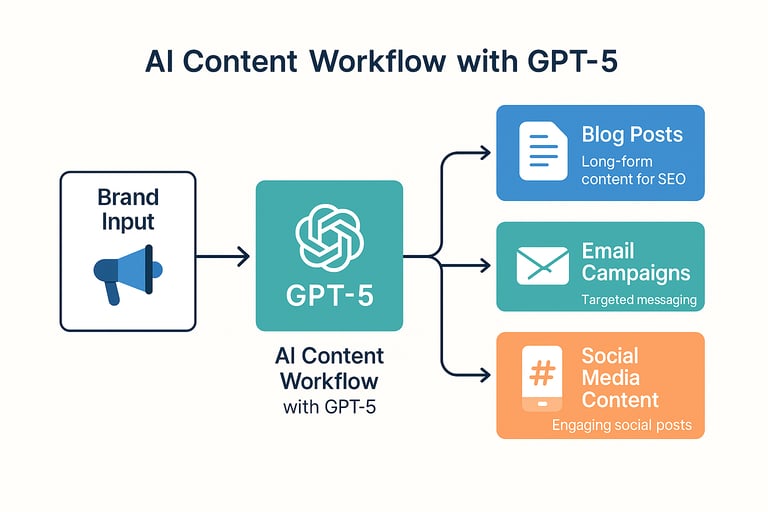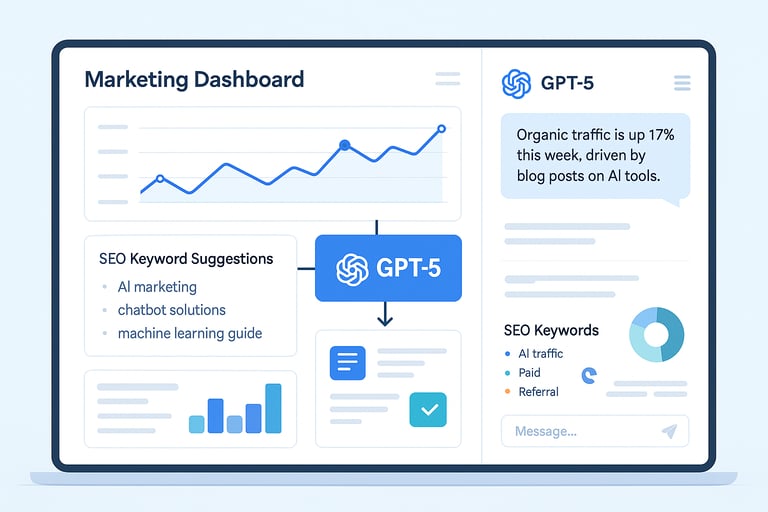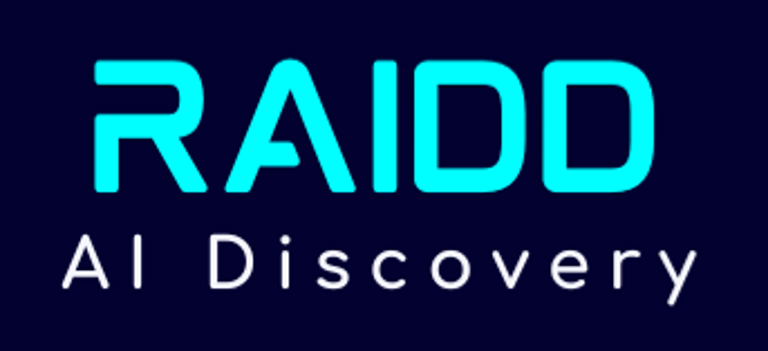ChatGPT-5 Is Here: How the Next-Gen AI Super Assistant Transforms Online Business
Discover how GPT-5 is transforming online business, marketing, and ecommerce with smarter automation, better content, and deeper customer insights. This guide unpacks real-world use cases tailored for modern entrepreneurs and digital teams.
TOOLS


ChatGPT-5 Is Coming: How the Next-Gen AI Super Assistant Will Transform Online Business
Imagine an e-commerce entrepreneur waking up in 2025. Over morning coffee, she asks her AI assistant for a quick rundown of overnight sales and customer feedback. Instead of sifting through dashboards, she gets a conversational summary highlighting trends, potential issues, even a few creative marketing ideas for the day. This isn’t sci-fi – it’s a glimpse into how ChatGPT-5, the upcoming upgrade to OpenAI’s generative AI, could soon revolutionize the way we do business.
In the next few weeks, OpenAI is expected to launch ChatGPT-5, and anticipation is running. Touted as the most powerful update yet, ChatGPT-5 promises major upgrades in reasoning, memory, and multimodal abilities. For entrepreneurs, marketers, and e-commerce operators, these advances aren’t just technical milestones; they herald a new era of productivity, customer experience, and growth. This article explores what’s changing with ChatGPT-5 and how you can harness it for business advantage (with a focus on B2C use cases, but also some B2B insights). We’ll keep things practical and professional, cutting through hype with real examples and best practices.


What’s New in ChatGPT-5 (and Why It Matters)
ChatGPT-5 isn’t just a version bump; it’s poised to be a “super assistant” that integrates a host of AI capabilities into one system. Early reports indicate the model will excel at complex, multi-step tasks thanks to improved reasoning and a larger memory window. In plain terms, it will handle longer conversations and remember more context, which is crucial for business dialogues that might span multiple interactions or lengthy documents.
Key expected improvements include:
Extended Context & Memory: ChatGPT-5 may handle much longer inputs and conversations. Some experts anticipate it could double the token limit of its predecessor, potentially analyzing documents or codebases without losing track of details. For businesses, this means the AI can digest an entire marketing plan or a hefty contract and give coherent output – saving hours of manual reading and cross-referencing.
Multimodal Mastery: Like GPT-4, the new model will work with text, but also images, voice, and even files – only now with more seamless integration across modes. You might feed ChatGPT-5 a product image and ask for ad copy, or speak a question and get both a spoken and written response. This versatility can streamline workflows (think of content creators quickly generating social posts from a photo, or customer support agents getting AI help analyzing a screenshot from a user).
Better Reasoning and Accuracy: OpenAI’s CEO Sam Altman hinted that GPT-5’s intelligence took even him by surprise, joking that an early response was so good it made him feel “useless compared to the AI”. We can expect fewer AI mistakes or “hallucinations” and more reliable logic. For entrepreneurs, this means trusting the AI with more critical tasks – from drafting business strategies to crunching financial data – with less double-checking.
Speed and Efficiency: With architectural upgrades (built on OpenAI’s new o3 architecture), ChatGPT-5 should be faster in generating responses. When you’re iterating a marketing slogan or solving a coding bug under deadline, those seconds add up. Faster AI means a smoother creative flow and quicker decision-making.
Tiered Models and Tools: Rumor has it ChatGPT-5 might come in tiers – a full-power version and lighter “mini” or “nano” models for specific uses. Also, OpenAI might introduce advanced features (like a Deep Research mode or specialized plugins) for premium users. This could translate into business users having more choice: a lightweight AI for simple tasks (quick customer emails) and an expert mode for heavy analysis or content generation.
In short, ChatGPT-5 is positioned to be more capable, context-aware, and versatile than any AI assistant before. But how does that translate into real-world business gains? Let’s look at the impact on customer experience, marketing, and operations.
For B2C businesses – especially in e-commerce and retail – ChatGPT-5’s improvements could directly boost the bottom line. One of the most exciting areas is customer experience (CX). With enhanced conversational abilities, GPT-5 can power chatbots and virtual assistants that feel even more natural and helpful to customers.
Personalized Shopping Assistants: Imagine a shopper on your website engaging with an AI assistant that remembers their preferences, answers product questions with expert detail, and even accepts voice queries or images of an item they’re looking for. ChatGPT-5’s multimodal talent will allow exactly that – customers could upload a photo of a dress they like and the AI can instantly recommend similar items from your catalog, or a user could ask out loud, “Do you have something like this in blue?” and get a prompt answer. The result is a smoother user experience (UX), where consumers feel like they have a personal shopper on call.
Higher Conversions through Better Engagement: There’s evidence that AI-driven engagement can lead to significantly higher conversion rates. A recent case study found that visitors who arrived via ChatGPT were far more likely to convert – about 16% conversion rate vs. just 1.8% for typical organic search traffic. Why such a jump? The AI had guided these users through their research and questions before they ever clicked on the site, so they arrived with intent and ready to act. In practice, a ChatGPT-5 powered assistant on your site can similarly educate and inform customers in real-time, reducing doubts and comparisons. By the time a user adds to cart, they’re confident – hence more likely to checkout. This targeted, high-intent engagement is gold for conversion rate (CVR) optimization.
24/7 Customer Service, With a Brain: Many brands already use chatbots for customer support, but older bots often frustrate users with canned responses. ChatGPT-5’s superior reasoning and memory mean a support chatbot can handle complex, multi-turn conversations and recall details from earlier chats. For example, if a customer last week asked about pricing on a product and now comes back asking about shipping, the AI can remember the context. This continuity feels more like talking to a knowledgeable human than a script. Satisfied customers are more likely to return and refer others. Plus, AI agents don’t clock out – late-night shoppers can get instant answers, capturing sales that might otherwise be lost. OpenAI’s own updates hint that GPT-5 will offer more reliable AI agents for customer service, capable of resolving issues without human hand-holding.
Reducing Friction = Boosting Loyalty: User experience researchers often talk about reducing friction – every extra click or unanswered question is a chance for the user to drop off. With a smart AI handling queries, product search, and even troubleshooting (“Why isn’t my promo code working?”), friction melts away. The shopper’s journey becomes easier and maybe even fun. Over time, this improves customer satisfaction and loyalty. Businesses can also save on support costs, freeing up human reps to handle the truly unique or sensitive cases while the AI covers the common ones.
For B2C companies, ChatGPT-5 isn’t just a flashy new tool; it’s a way to differentiate the shopping experience. Brands that integrate it thoughtfully can offer concierge-level service to every online visitor, at scale. In an era where consumers expect instant gratification, that’s a competitive edge.
AI-Powered Marketing and Content Creation (Work Smarter, Not Harder)
Modern marketing is equal parts creativity and data-driven strategy – and ChatGPT-5 is set to supercharge both. Content creation is one area to highlight. Many entrepreneurs and marketers have already experimented with AI for writing blog posts, product descriptions, ad copy, and social media updates. But often, these require heavy editing to match the brand voice or to fact-check. With better logic and more knowledge, GPT-5’s copywriting output should be more accurate, in-tune with prompts, and even more creative, cutting down editing time.
Fueling Content at Scale: Consider an online business owner who needs to create dozens of product descriptions or a marketer tasked with drafting a new email campaign. ChatGPT-5 can analyze your brand style guidelines (you could feed it a few examples of your best content) and then produce on-brand, polished copy in seconds. Thanks to an extended context window, it might handle entire content calendars in one go – for instance, generating a series of 10 blog outlines with SEO keywords integrated, or 50 social media posts scheduled around a product launch. Early adopters of AI in marketing are already seeing results: 45% of marketers use AI tools like ChatGPT in their processes, primarily for tasks like data analysis, content generation, and personalization. And notably, ChatGPT is the go-to AI tool, used by 71% of marketers who utilize AI. GPT-5 will likely cement that position by making AI content even easier and more effective.


Elevating Customer Experience in E-Commerce (B2C Focus)
Search Engine Optimization (SEO) and Analytics: On the SEO front, GPT-5 could become an optimizer’s best friend. It can potentially keep up with real-time knowledge, meaning it can be aware of current trends or recent news to create timely, relevant content that search engines (and readers) love. Need meta tags and schema markup for your pages? The AI could generate those too, tailored to the latest search algorithms. And it’s not just content – the analysis side is just as exciting. Marketers can ask GPT-5 to sift through web analytics data or campaign metrics and get plain-English insights (“Which traffic source gave us the best conversion last quarter and why?”). The new model’s knack for smarter data analysis and reporting means even small businesses without a dedicated data team can derive enterprise-grade insights from their numbers.




Personalization at Scale: One of the highest value uses of AI in marketing is personalization – crafting messages or experiences for different customer segments. GPT-5 can take this to the next level by dynamically generating content for each user. For example, an email newsletter powered by GPT-5 might have 10,000 variations for 10,000 subscribers, each tailored to individual browsing history and preferences. In fact, personalization is already a top priority for AI in marketing (42% of marketers using AI cite personalization as a key use). ChatGPT-5’s deeper contextual memory would allow it to remember a user’s interaction history with your brand and keep tone and recommendations consistent across sessions. The benefit? Better engagement and higher conversion, as customers feel understood.
Efficiency = More Creative Strategy Time: Marketing teams embracing AI have reported striking productivity gains. In one survey, 83% of e-commerce marketers said their productivity increased because of AI, and 84% saw performance improvements as well. By letting GPT-5 handle the heavy lifting on things like first drafts, routine reports, or A/B test suggestions, your team can focus on big-picture strategy, creative brainstorming, and the human touchpoints that AI can’t replace. In fact, 84% of those marketers said AI does the grunt work, freeing them to concentrate on more valuable tasks. For an entrepreneur or a small business, this might mean you suddenly gain extra hours in the day – time you can spend refining your product or talking to customers, instead of wrestling with copywriting or spreadsheets.
It’s worth noting that while GPT-5 will be powerful, it works best in human-AI collaboration. Think of the AI as an extremely knowledgeable junior partner: it can generate ideas and material at scale, but you provide the direction, the creative judgment, and the final polish. Businesses that master this collaboration will sprint ahead of competitors still doing all the work manually.
Smarter Decision-Making and B2B Applications (From Insights to Proposals)
While much of the buzz is around customer-facing uses, ChatGPT-5’s impact on internal and B2B scenarios could be just as profound. Entrepreneurs and managers often have to make decisions based on mounds of data – financial reports, market research, customer feedback, you name it. GPT-5 can act like a super-analyst, digesting huge volumes of information and presenting the insights you need.
Virtual Business Analyst: With its longer memory and improved reasoning, ChatGPT-5 will be capable of analyzing extensive datasets or lengthy reports. You could upload a 100-page sales report or feed in the last year’s worth of Google Analytics data, and then have a natural conversation about it. “AI, what were the key factors that made our Q4 sales spike?” GPT-5 might highlight a particular promotion or external trend, backing its explanation with data points from the report. If you’re weighing decisions (like whether to expand into a new market), the AI can even perform a quick SWOT analysis or summarize relevant market research. By integrating real-time knowledge, it could incorporate the latest market stats or news in its counsel – something previous models struggled with. In essence, GPT-5 can serve as an on-demand consultant or data scientist, helping small businesses punch above their weight in strategic planning.
Empowering B2B Sales and Communication: In B2B marketing and sales, relationships and information are key. ChatGPT-5 could help sales teams by quickly summarizing a prospect’s business (from public data), brainstorming personalized pitches, or even role-playing a sales call to practice responses. Writing proposals or responding to RFPs (Request for Proposals) is another heavy task where AI can assist – GPT-5 could draft substantial parts of a proposal by pulling the relevant details from your knowledge base and tailoring the tone to the client’s priorities. The model’s expected ability to handle very long documents means it can incorporate all the minutiae of a client’s requirements directly into the draft, ensuring nothing is missed. This not only saves time but could improve the quality of responses and win rates.
Even day-to-day B2B communication stands to gain. Think of the countless emails, memos, and reports professionals write – GPT-5 can generate clear, polished drafts for routine messages (“Here’s the weekly project update”) or translate dense technical jargon into accessible language for a client. The consistency and speed can free up professionals to spend more time on client relationships and creative problem-solving.
Case in Point – Small Business Wins: Real-world examples are already showing the promise of AI in business decision-making. According to the U.S. Chamber of Commerce, about one in four small businesses have adopted AI in some form, seeing improvements in areas like marketing and customer communications. For instance, a family-owned coffee roaster used AI tools to analyze customer lifetime value and craft SEO-friendly product descriptions, achieving better marketing performance with fewer resources. In another example, a boutique cookie dough company leveraged ChatGPT for social media and content development, helping them expand their reach and even optimize operations like ingredient sourcing. These stories underline a common theme: AI allows small teams to do big things. ChatGPT-5 will amplify this effect – its advanced capabilities can further level the playing field between enterprises and lean startups or small businesses.
And it’s not just small firms. Large enterprises are eagerly awaiting GPT-5 for everything from summarizing research papers and legal documents to generating code for software prototypes. In fact, the introduction of GPT-4 saw companies in software development, finance, and logistics weave AI into their workflows, and GPT-5 is expected to enhance those applications with greater reliability and speed. For any business – B2C or B2B – the mantra is becoming clear: adapt AI into your operations, or risk falling behind competitors who do.
Preparing Your Business for the ChatGPT-5 Revolution
With so much potential, it’s easy to get excited. But as any business leader knows, new technology needs to be implemented thoughtfully. Here are some best practices as you get ready for ChatGPT-5:
Start Experimenting Now: If you haven’t already, familiarize yourself with AI-assisted workflows using the current tools (like GPT-4). Identify where AI brings the most value in your context – is it content creation, customer service, or data analysis? By the time GPT-5 rolls out, you’ll have a playbook for integration. Early movers will have an advantage.
Educate and Upskill Your Team: Your employees might be as excited (or anxious) as you about AI. Provide training on how to use tools like ChatGPT effectively – for example, how to craft good prompts to get useful outputs. Emphasize that GPT-5 is there to assist, not replace; it takes over repetitive tasks so humans can focus on creative and strategic work. This can reduce fear and increase adoption. In fact, a majority of marketers already see AI as a colleague of sorts, handling the grunt work while they concentrate on higher-level tasks.
Set Guidelines and Quality Checks: Even with improved accuracy, AI will not be infallible. Establish an internal review process for any content or analysis GPT-5 produces before it goes live or informs major decisions. Designate team members to fact-check critical outputs and ensure the AI’s work aligns with your brand values and voice. GPT-5 will have fewer hallucinations, but maintaining a human in the loop is still wise – think of it as AI QA (quality assurance).
Integrate with Your Systems: Plan for how to technically integrate ChatGPT-5 into your business. This could mean using OpenAI’s API to plug GPT-5 into your e-commerce platform, CRM, or support ticket system. If you run a Shopify store, for instance, you might connect GPT-5 to auto-answer customer questions about orders. Many e-commerce platforms already offer AI add-ons and we can expect more GPT-5 integrations. Work with your developers (or SaaS providers) to ensure a smooth deployment once it’s available.
Budget and Access Considerations: Keep in mind that cutting-edge AI may come at a price. ChatGPT-5 will likely be offered to paying subscribers or enterprise customers first. If having priority access is important, consider the cost of ChatGPT Plus or enterprise plans as an investment in productivity. Also monitor if OpenAI offers different model sizes or an on-premise solution for your needs. The ROI can be significant if it streamlines key operations or increases sales.
Stay Ethical and Transparent: As you adopt AI, be mindful of transparency. If customers are interacting with a chatbot, many experts recommend disclosing it’s AI to maintain trust. Also, ensure compliance with privacy laws when feeding data to GPT-5 – for instance, avoid inputting sensitive personal information unless you have consent. Using AI responsibly will safeguard your brand’s reputation in the long run.
By preparing on these fronts, you’ll be ready to hit the ground running. The goal is to seamlessly weave ChatGPT-5 into your business fabric so that it enhances what you already do well and helps you tackle what you couldn’t before.
Conclusion: Embracing the Future of AI in Business
ChatGPT-5 represents a significant leap forward in AI capabilities, but its true impact will be measured by how we apply it. For entrepreneurs, online business owners, and marketers, this next-gen AI could be a game-changer – if you take the initiative to harness it. From dramatically improving customer engagement and conversion rates, to turbocharging content production and decision-making, the possibilities are vast.
Importantly, ChatGPT-5 arrives at a time when AI competition is heating up and digital experiences are a key differentiator for businesses. Those who quickly adapt and learn to collaborate with AI will not only save time and resources, but also deliver more value to their customers. It’s telling that early AI adopters in the small business realm have already seen growth and efficiency gains – a trend bound to accelerate with even smarter tools.
In the end, success with ChatGPT-5 (and AI in general) will come down to a balanced approach: leveraging the technology’s strengths while maintaining human creativity, oversight, and empathy. Businesses that strike this balance will find that AI is not just a buzzword, but a powerful ally in driving innovation and competitive advantage. The age of the AI super assistant is almost here – and it’s time to get ready for it.
References
Amanda Caswell, “ChatGPT-5 launch expected soon — here’s everything we know so far,” Tom’s Guide – (July 28, 2025)tomsguide.com.
Oleg Khanachivskyi, “ChatGPT 5 Release Date: What to Expect in 2025,” LitsLink Blog (June 20, 2025)litslink.com.
Nick Haigler and Garman Chan, “Case Study: 6 Learnings About How Traffic from ChatGPT Converts,” Seer Interactive (June 3, 2025)seerinteractive.com.
Mor Mester, “55+ Surprising ChatGPT Statistics You Need to Know (2025),” Email Vendor Selection (Nov 19, 2024)emailvendorselection.com.
Jordan Crenshaw, “Enhancing Entrepreneurship: AI’s Big Impact on Small Business,” U.S. Chamber of Commerce (May 2, 2024)uschamber.com.
